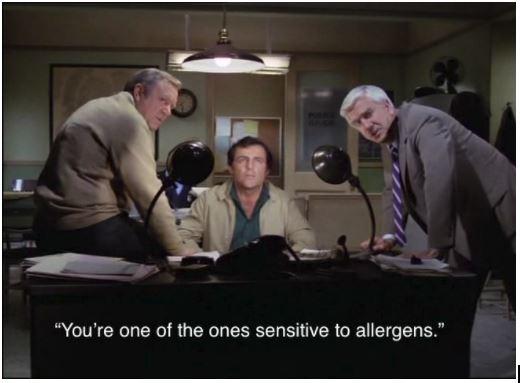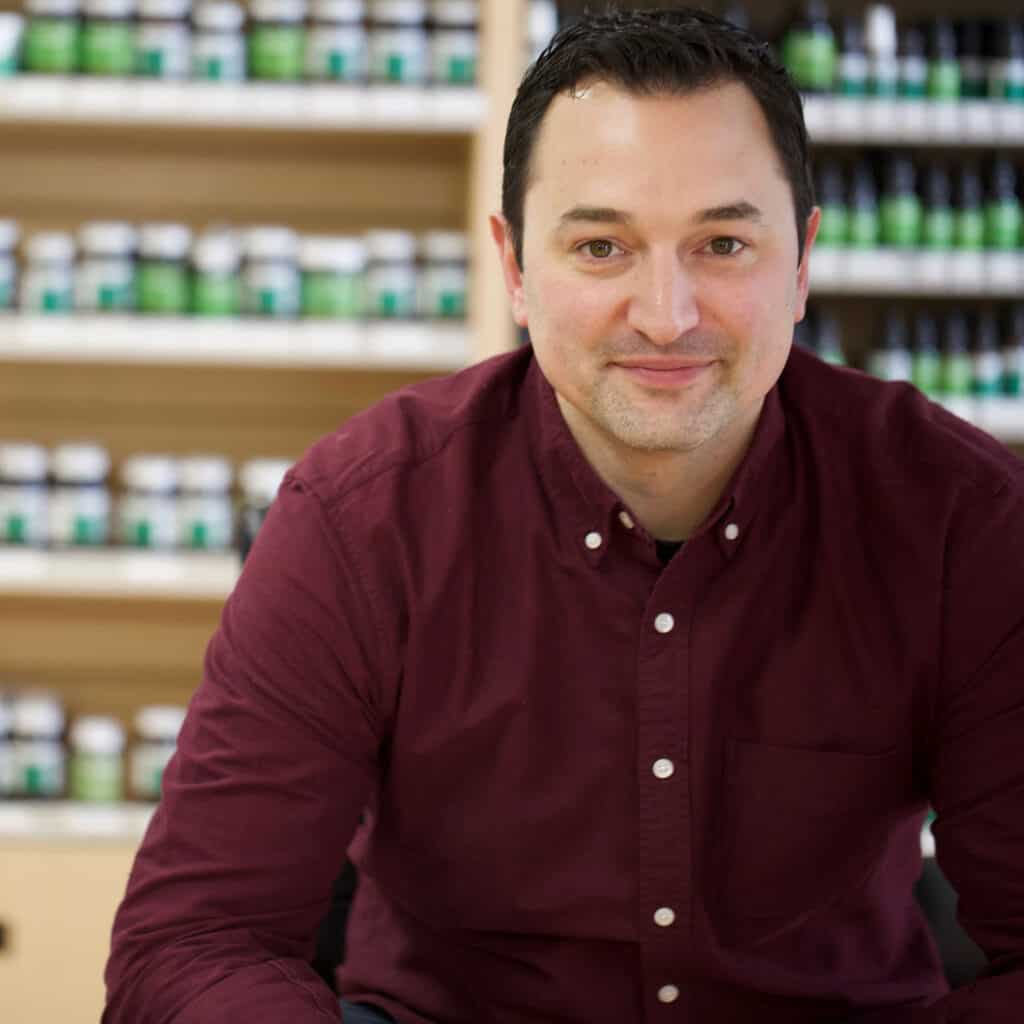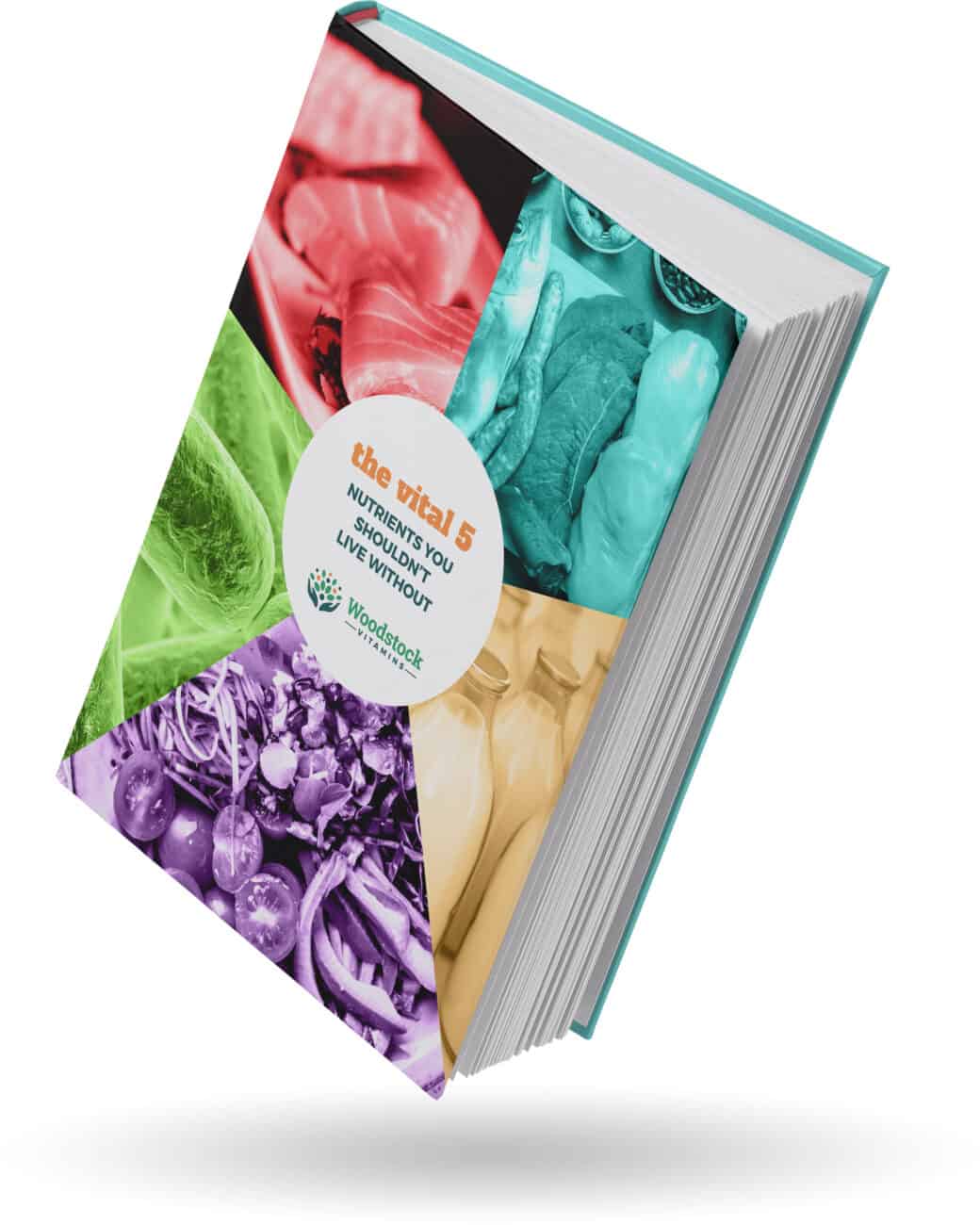Even though there’s a nip in the air still (here in the Northeast at least), pollen is starting to fly. With it comes stuffy noses, sneezing, runny eyes, and all sorts of other things opposite to the beauty of the season.
We have a unique perspective on allergy support here at Woodstock Vitamins. I’m a pharmacist. In pharmacy school, the treatment of allergies is one of our first clinical lessons. It’s easy, very well understood, and there’s a nice mix of traditional and natural products right at consumers’ fingertips – no prescription necessary.
I’m going to give you this then from the perspective of a pharmacist more than a vitamin expert. In doing so, you can see the broader picture and have a deeper understanding of allergies and the options. Hopefully, then, you can make wiser decisions around allergies.
Let’s start with a biology lesson!
Histamine – What A Punk!
Blame the entirety of our suffering in allergy season on one roughneck: histamine.
Histamine is a compound found in practically EVERY tissue of the human body. Histamine is stored in cells called mast cells. Histamine’s effect is to dilate blood vessels, accelerate heart rate, increase stomach acid, and contract muscle in the lungs. It is a crucial part of our immune and inflammatory responses, which need all of those types of things to happen in order to protect us from invaders.
Opening up those blood vessels makes them leakier. This means fluids (and compounds) can escape the tubes MUCH easier. This is good if we need immune cells to come gobble up infections or if we want to drain out infected tissue. This fluid then goes into spaces it normally doesn’t occupy, which causes swelling in some tissues. The leaky fluid can also fill up the cavities or sinuses like the ones in your head, making you feel all stuffy.
A tissue gets ruptured physically (a bump, cut, or burn) OR a foreign invader interacts with the mast cell, the mast cells that hold histamines pop, and histamine goes everywhere. The histamine interacts with practically everything around it, which can cause more histamine release, and the dominos keep falling.
A couple important takeaways here: First, our immune response and release of histamine is an overreaction. It’s intentionally that way. Better to be safe than sorry, evolution has shown. Our bodies literally dump histamine like crazy, causing more histamine to be dumped, etc etc. That’s something to be aware of, not thrilled about, but we have to be ok with it. Our body goes nuts when histamine is released, it makes us not feel good, but we have to understand that’s the way it is.
Second, allergens (things in your body that aren’t you) trigger mast cells to break and release histamine. Some people may be more sensitive to allergens than others. There’s a genetic (aka “nature”) component, but research points more towards exposure (aka “nurture”) dictates our sensitivity. Kids exposed to peanut butter young (or in the womb) have a lower risk of peanut allergies later, as an example. Twins can have different allergies. Breastfed kids will have fewer allergies than formula fed kids, on average. Our sensitivity can change over time; someone who has never had allergies their whole lives can get allergies later in life.
These points help us understand allergies better, which will make it easier for us to treat them. A note: Only doctors and pharmacists treat using medications. If we use supplements, we say we provide immune or allergy support. Don’t change ANYTHING regarding your treatment without talking to your doctor first.
Allergy Strategies
Say you’re one of the ones sensitive to allergens…

Did you get that reference?
In broad terms, there are two things we can do to make your suffering less bad:
- Don’t get exposed to allergens
- Deal with the aftermath of being exposed to those allergens
Rule Number 1 when treating allergies is try to reduce or limit exposure. Seasonal allergies like those we’re about to deal with are from allergens that are practically everywhere. Food allergens are much easier (mostly) to avoid than say pollen, unless you are going to lock yourself indoors. It isn’t fair to just poo-poo this strategy altogether, though.
Many people complain of allergy symptoms at night. Limiting exposure could mean getting hypoallergenic covers for pillows and mattresses, or sweeping and cleaning the dust monsters under the bed more regularly. It’s difficult to avoid pollen-dense areas (like Woodstock!), but the relationship between the geography, pollen, and allergies should be understood.
It seems the real-life strategy we’ll have to employ is dealing with the fallout. Here’s how we can attack this problem:
Block Histamine
Histamine is released after the mast cell gets exposed to the allergen and bursts. We can then block histamine using an antihistamine (clever name, right?), to stop the released histamine from causing the inflammatory response we don’t like.
Imagine putting a full economy-size box worth of rice in a balloon, tying off the end, holding it by the knot, and popping that droopy beast. An antihistamine would be like you and four of your friends trying to catch all the rice. You can get a bunch, but it’s going to be a fight that you probably won’t win. Antihistamines have to try to block all the histamine that’s released, which is an uphill battle. This is why some antihistamines are successful for some and some are not. The agent may not be enough hands trying to catch the rice.
Antihistamine compounds come with a few other liabilities. Some older antihistamine have properties that can cause drowsiness, confusion, and even memory loss in older patients. Modern antihistamines like Claritin or Allegra have less of a chance of that compared to Benadryl, which is why they are recommended a lot. If you need to pack a punch, though, Benadryl will give results in hours, where Claritin or Allegra would take days. Some natural products have anti-histamine activity, and we’ll discuss those in a bit.
Antihistamines are available in eye drops over-the-counter now. This is great because it helps address one of the worst symptoms of allergies – runny, itchy eyes. Antihistamines can be applied directly to sinuses via prescription nasal sprays too. I’m sure these will be over the counter soon enough…
Stop Mast Cells From Popping
Instead of trying to catch the rice, what if we just stopped the rice from coming out of the balloon? There are medicines that make mast cells more pop-resistant. Nasalcrom is a spray that makes the mast cells in the nasal and sinus lining stronger, making it less likely you’ll suffer from congestion with allergies. These options are great, especially when applied directly like in an inhaler or nasal spray (right to the lungs or sinuses, respectively).
Work Deeper In The Immune System
Modern compounds like Singulair work deeper in the immune response to reduce allergy-induced inflammation. These compounds take a few weeks before we can really see a big benefit, but people with allergies and asthma have shown great benefit in taking these. These products have very little liabilities and are safe even for kids.
Throw the Sink At It
Treating the specific symptoms of allergies is another option. You can break up the congestion using decongestants, steroids, saline sprays, or even things called nasal douches. You can stop spasming in the lungs by using inhalers, which are called bronchodilators (Albuterol or Ventolin are the common names). You can even add steroids to the inhalers to reduce inflammation (Advair, Dulera).
Why Am I Telling You All This?
I tell you all this because I think that medical options, in most cases, are the better options here. At least in some part.
We walk The Middle Path of Wellness, so we embrace traditional medicines when they are better options. If a traditional medicine has proven effectiveness, minimal impact on the body, plays well with other drugs or supplements, and long-term leaves no lasting effects, that makes it a great option. Modern antihistamines like Claritin or Allegra will win out over natural options for antihistamines, in my honest, expert opinion.
Plus, allergies can be serious. Allergies can cause a low underlying stress on your body – in particular, your lungs. A stress on your lungs is a stress on your heart. Some people react strongly to allergens making breathing difficult and putting them MUCH closer to a severe illness than others. It’s best to address allergies aggressively.
Some people have mildly bothersome allergies and prefer natural products. We understand. I only want to keep it real with everyone. As we recently illustrated, the most popular supplement brands are owned by mega-corporations, including “Big Pharma”. The natural vs traditional discussion is not as black and white as it is marketed to us.
One point that I have postulated: How possible is it that these poor quality supplements could contain potential allergens and not disclose it?
If you choose Vitality Approved supplements, you can be guaranteed you are getting best-in-class options. Supplements that are what they say they are. Unfortunately, many people use products that are contaminated with horrible stuff. Worse, especially in the case of allergies, is if the allergy support product has none of the ingredients actually in it to support allergies.
Natural products are out there and many people want to choose those products first. Let’s discuss the different options so you have a clearer picture when making your allergy support decisions.
Natural Allergy Support Products
Bioflavonoids
Quercetin is a bioflavonoid, which is a group of compounds found making up the colorful parts of plants like fruits and vegetables. Quercetin is found in high amounts in things like capers, radishes, onions, kale, and cranberries.
Bioflavonoids from our diet have numerous health benefits, especially in the antioxidant effects.
Quercetin and its precursor DHQ have been used traditionally for antihistamine effects. It is believed the DHQ form of quercetin is its more potent form. Many quercetin products leave a lot to be desired. Bioflavonoids are sensitive to processing and many finished products lack any potency. Even then, bioflavonoids need to be ingested in much higher amounts found in most supplements. It’s important to take potent supplements, so look for about 1,000mg a day. Based on available data, 1,000mg is likely safe, especially when used for the short time allergy support is needed.
It was Shakespeare that said all Bioflavonoids come in pairs. I think. Rutin is another bioflavonoid that is found in allergy support products, often paired with Quercetin. It is proposed rutin can have an impact on reducing allergy-induced inflammation, but as with most supplements, we don’t 100% know.
Nettles
Nettles is probably the most popular herbal product for allergy support. It’s been used for its antihistamine effects since Ancient Greece. Think of it as a natural (but weaker) Benadryl. Because it is an herb, there is a high risk of adulteration and contamination. Look for nettle herb – not the root. Many people who use it report to us little to no drowsiness when taking at the labeled doses. if someone has an allergy and want a natural product, this is the one I reach for for them.
N-Acetylcysteine
N-Acetylcysteine (NAC) is a derivative of the amino acid cysteine. NAC is a precursor of glutathione, an important component used to metabolize and clear compounds in the body. If someone has an acetaminophen overdose, for example, their body’s glutathione is overworked and NAC is used by hospital staff to clear the acetaminophen from the body.
NAC is also a mucus-thinning agent. NAC can be used in patients with severe lung diseases like cystic fibrosis to help break up mucous and make breathing easier.
NAC isn’t only a drug, but a supplement as well. Some people take NAC in a daily dietary supplement because of the benefits on mucous production. A review article looked at the 39 or so studies on the matter. From what I understand from this article, there is some potential positive impact on people with chronic bronchitis by taking the oral product, but more studies need to be done.
Natural Nasal Sprays
Allergy sufferers with sinus congestion can use saline nasal sprays to help break up the mucous. There isn’t much more natural than salt water! We have a couple saline nasal sprays with some added natural ingredients in there that gives the saline a little boost.
Xylitol is a unique sweetener. Besides being a sugar substitute, it has some medical credibility. For example, 9 out of 10 dentists agree chewing Trident after meals yadda yadda yadda… The reason Trident is a favorite of the teeth-wizards is because it contains Xylitol. Xylitol works by changing the pH of the area and lowering bacterial growth. Xylitol infused saline nasal sprays do the same in the sinuses, but it has the added benefit of preventing mucous from adhering.
The effects of xylitol are temporary; it only works when it is present, and it isn’t present for very long. Just like gum chewing, xylitol nasal sprays must be sprayed every few hours to benefit.
If you are really adventurous, try our xylitol nasal spray with added capsicum, an ingredient found in pepper.
Sinus Blaster
Another option is to eat foods that have a natural sinus-clearing effect. Garlic, cayenne pepper, horseradish… Just reading those words cleared my sinus.
Our Sinus Blaster product is an oral product that has those ingredients. It doesn’t taste great (it’s a weird mint flavor), but many people come back to it again and again to blast their sinuses.
AVOID – supplement eye drops!
Comprehensive Allergy Support
When it comes to natural options for allergies, my recommendation is to do all of it. Each piece alone will have some small impact. Altogether, you’ll get the job done.
Whether you are going the natural or traditional path, using multiple treatment types will give you the greatest result. This makes sense logically and is part of the treatment plans we made up back in pharmacy school. Histamine: it’s everywhere and when it comes out, it comes out in droves. Histamine blockers, mast cell stabilizers, decongestants, inhalers, steroids – you’ll have to throw the sink at it.
Mixing and matching with natural and traditional is a great option. Maybe use a traditional antihistamine along with a Xylitol nasal spray. Maybe use a steroid nasal spray along with nettles capsules.
As it pertains to the natural options for allergy support, our own Allergy Support is the best-in-class way to do that. It has all of these natural options in a single capsule, made properly, at doses that showed promise in the limited clinical trials available to us.
Timing Is Everything
Taking allergy medicine just as needed is a day late and a dollar short. Many newer antihistamines take days to improve symptoms. Some allergy products take weeks.
Just like with comedy, timing is everything with allergies. It is important to get started on some allergy support products BEFORE the season peaks. We recommend starting before allergy seasons begin (early spring and early fall). Have the agents already in your body and ready to go.
Almost as important is how long you take your allergy products. Most allergy experts recommend taking allergy medicine straight through the season. In the spring, that means deep into mid to late summer. In the fall, that means right past the holiday season into winter. Some people, though, have allergies during both seasons. It’s probably best to just take something all year round.
The symptom-relievers like the nasal sprays and inhalers may not have to be used all the time. These are probably used more regularly when symptoms are their worst, but their use can decrease as needs change.
Be Prepared
My Boy Scout training comes to the surface when discussing allergies with our customers.
First, we have to understand what causes our allergies. In the Spring, it’s pollen. It could be mold (like in the Fall as the trees and plants die), dust, animals, or foods.
Second, we must know what is causing the allergy symptoms and why. Histamine releases quite dramatically, causing swelling, congestion, itch, and even more severe symptoms like low blood pressure, high heart rate, and spasming lungs.
Third, we should know what we can do to stop it. Avoiding allergens is great, but difficult for many. Taking histamine-blocking agents, medicines that strengthen histamine-carrying cells, or medicines that work deeper in the immune system to reduce the impact of allergens are all great options. Depending upon the person, one or more of these options are used routinely. Natural products have less certainty but have been used because it is believed they have similar effects. Ensuring you get a high quality, combination natural product is best as it eliminates any variables.
Finally, we need to know when allergy season is worse for us and take action in advance.
In case you didn’t gather already, that time is now. Make this the first year you control your allergies – not the other way around.
Just trying to keep it real…

Neal Smoller, PharmD
Owner, Pharmacist, Big Mouth



